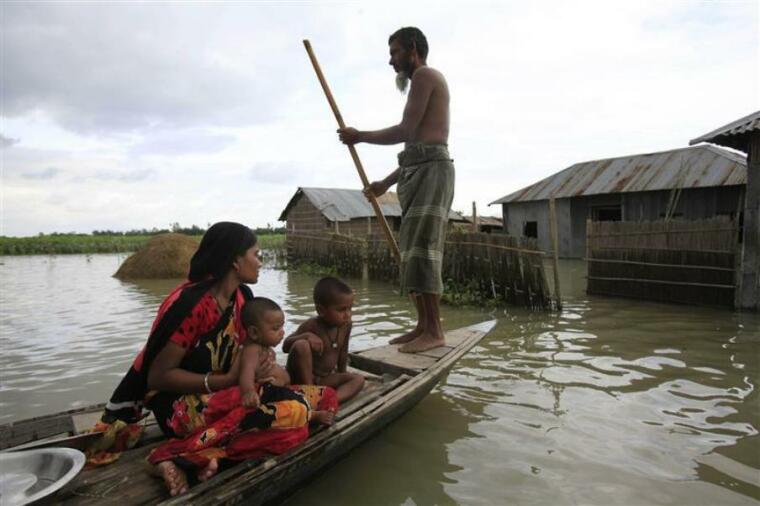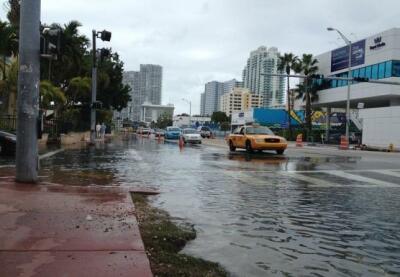Christian Aid report lists places to be most affected by climate-induced coastal flooding
A Christian organization published a report stating which areas are most at risk of climate-induced coastal flooding in the future, and these places are mostly located in countries that are high carbon polluters: India, China, and the U.S.
"Climate change is not an abstract concept, it is increasingly a reality felt by millions of people around the world," the report by non-profit organization Christian Aid says. "For those living in coastal regions it is threatening their lives and their livelihoods, and this report shows how that impact is only going to get more severe."

According to the study titled "Act Now Or Pay Later: Protecting a billion people in climate-threatened coastal cities," more than 1 billion people who live in coastal cities are at risk of suffering from flooding by 2060. Most of these places are already experiencing a combination of extreme weather, storm surges, and the rise of sea level.
On top of the list of countries expected to have the most number of people living in low-lying coastal zones by 2060 are: China with 244.8 million (144 million in 2000); India with 216.4 million (63.9 million in 2000); and Bangladesh with 109.5 million (63.1 million in 2000). This is followed by Indonesia, Vietnam, Egypt, Nigeria, the U.S., Thailand, and the Philippines.
Number one on the list of cities whose population could be most exposed to coastal flooding by 2070 is Calcutta, India (14 million vulnerable people); followed by Mumbai, India (11.4 million); then Dhaka, Bangladesh (11.1 million). It is followed by Guangzhou, China; Ho Chi Minh City, Vietnamn; Shanghai, China; Bangkok, Thailand; and Yangoon, Myanmar. Miami, U.S.A. is listed with 4.8 million people projected to be at risk.

Meanwhile, assets including businesses and property that are projected to be the most exposed by 2070 are Miami, Guangzhou, and New York. The other top financially vulnarable cities are Calcutta, Shanghai, Mumbai, Tianjin, Tokyo, Hong Kong, and Bangkok.
The report, which was published on May 16 in time for Christian Aid Week, says that up to 34 percent of the global population in 1960 lived in cities, but this has risen to 54 percent in 2014. The growth in urban population has been observed in less developed places in the world, and it is expected that by next year, majority of people, even in countries that are least developed, will be residing in urban areas -- and much of these are areas along coastlines. By 2060, more than 1 billion poeple all over the world could be residing in low-lying coastal areas, majority of which will be in Asia. The study says that it is mostly the poor who move to coastlines because these places are vulnerable.
"Evidence shows that, from New Orleans to Dhaka, it's the poorest who are by far the most vulnerable," the report says. "They tend to live on more exposed land, often in informal settlements with poorly built infrastructure that is easily damaged by flooding, extreme weather and storm surges. They are also the least able to recover, with no insurance cover, poor land tenure, and no social or financial safety nets."
Apart from rising sea levels, storms, and extreme weather, the destruction of flood plains and mangrove forests due to coastline population growth would contribute to further risk because these serve as natural barriers against extreme conditions.
"Climate change will play an increasing role in causing – and exacerbating – humanitarian disasters, especially along coastlines," says the report. "That's why it's vital that we have some joined-up thinking and that climate mitigation and adaptation become a key part of national and international efforts to tackle humanitarian crises."
The 2014 National Climate Assessment says that since 1880, global sea level has risen by 8 inches, and it is expected to rise by one to four more feet by 2100.
 Christians don't have to affirm transgenderism, but they can’t express that view at work: tribunal
Christians don't have to affirm transgenderism, but they can’t express that view at work: tribunal Archaeology discovery: Medieval Christian prayer beads found on Holy Island
Archaeology discovery: Medieval Christian prayer beads found on Holy Island Presbyterian Church in America votes to leave National Association of Evangelicals
Presbyterian Church in America votes to leave National Association of Evangelicals Over 50 killed in 'vile and satanic' attack at Nigerian church on Pentecost Sunday
Over 50 killed in 'vile and satanic' attack at Nigerian church on Pentecost Sunday Ukrainian Orthodox Church severs ties with Moscow over Patriarch Kirill's support for Putin's war
Ukrainian Orthodox Church severs ties with Moscow over Patriarch Kirill's support for Putin's war Islamic State kills 20 Nigerian Christians as revenge for US airstrike
Islamic State kills 20 Nigerian Christians as revenge for US airstrike Man who served 33 years in prison for murder leads inmates to Christ
Man who served 33 years in prison for murder leads inmates to Christ


 Nigerian student beaten to death, body burned over ‘blasphemous’ WhatsApp message
Nigerian student beaten to death, body burned over ‘blasphemous’ WhatsApp message 'A new low': World reacts after Hong Kong arrests 90-year-old Cardinal Joseph Zen
'A new low': World reacts after Hong Kong arrests 90-year-old Cardinal Joseph Zen Iran sentences Christian man to 10 years in prison for hosting house church worship gathering
Iran sentences Christian man to 10 years in prison for hosting house church worship gathering French Guyana: Pastor shot dead, church set on fire after meeting delegation of Evangelicals
French Guyana: Pastor shot dead, church set on fire after meeting delegation of Evangelicals ‘Talking Jesus’ report finds only 6% of UK adults identify as practicing Christians
‘Talking Jesus’ report finds only 6% of UK adults identify as practicing Christians Mission Eurasia ministry center blown up in Ukraine, hundreds of Bibles destroyed: 'God will provide'
Mission Eurasia ministry center blown up in Ukraine, hundreds of Bibles destroyed: 'God will provide' Church holds service for first time after ISIS desecrated it 8 years ago
Church holds service for first time after ISIS desecrated it 8 years ago Burger King apologizes for 'offensive campaign' using Jesus' words at the Last Supper
Burger King apologizes for 'offensive campaign' using Jesus' words at the Last Supper Uganda: Muslims abduct teacher, burn him inside mosque for praying in Christ’s name
Uganda: Muslims abduct teacher, burn him inside mosque for praying in Christ’s name